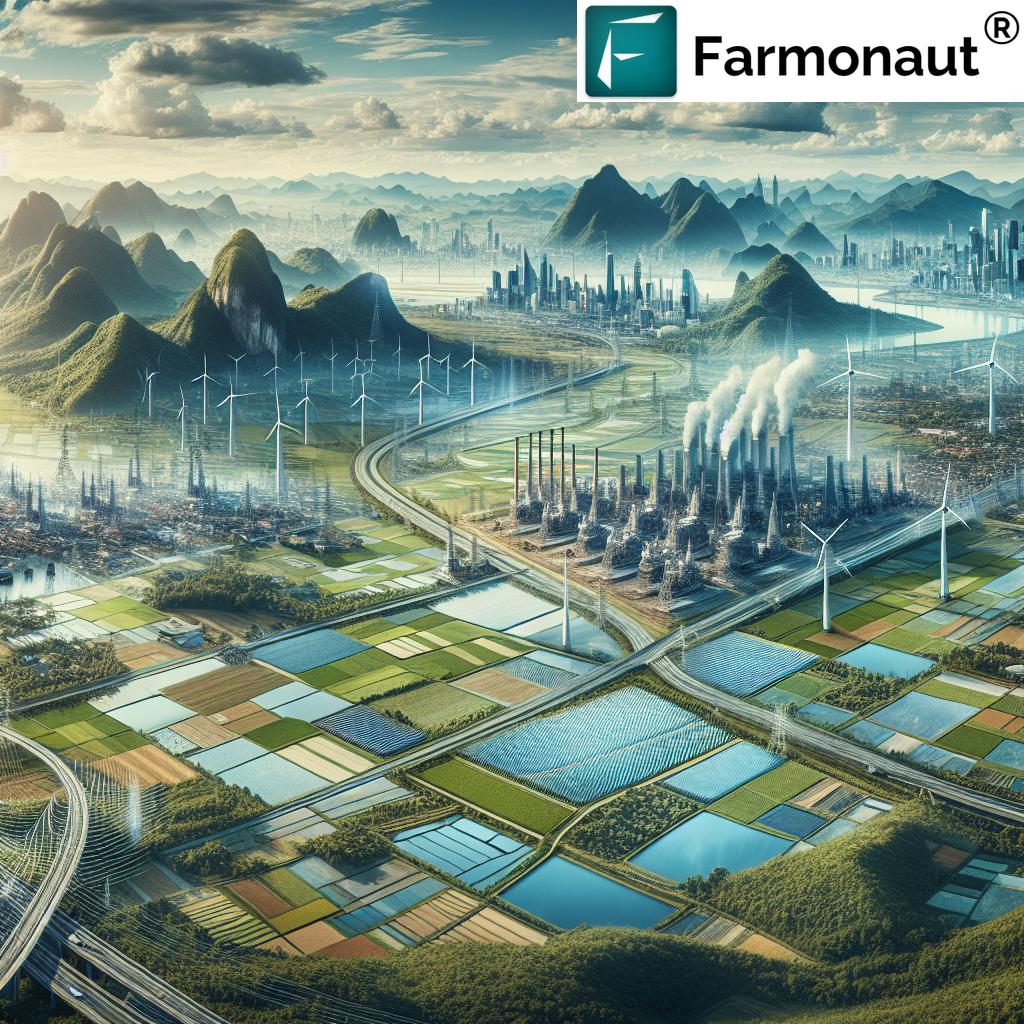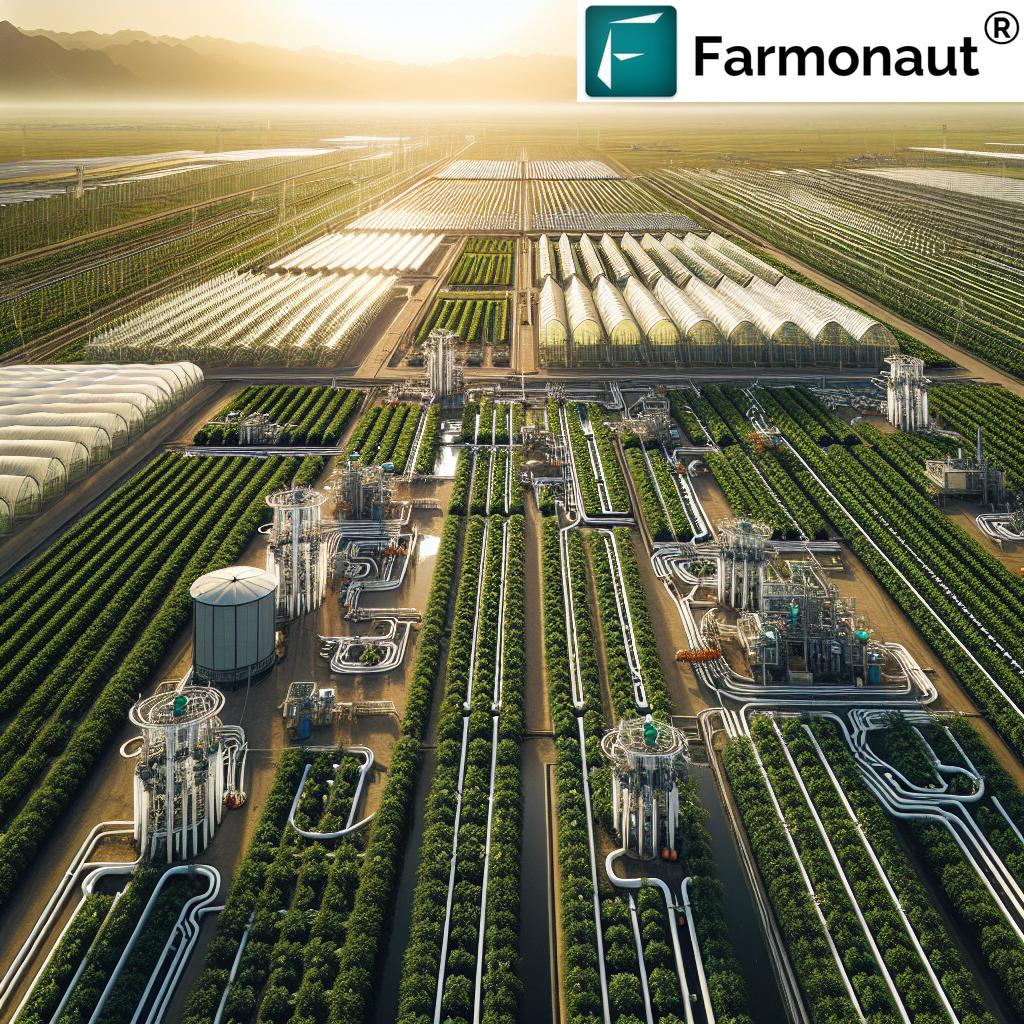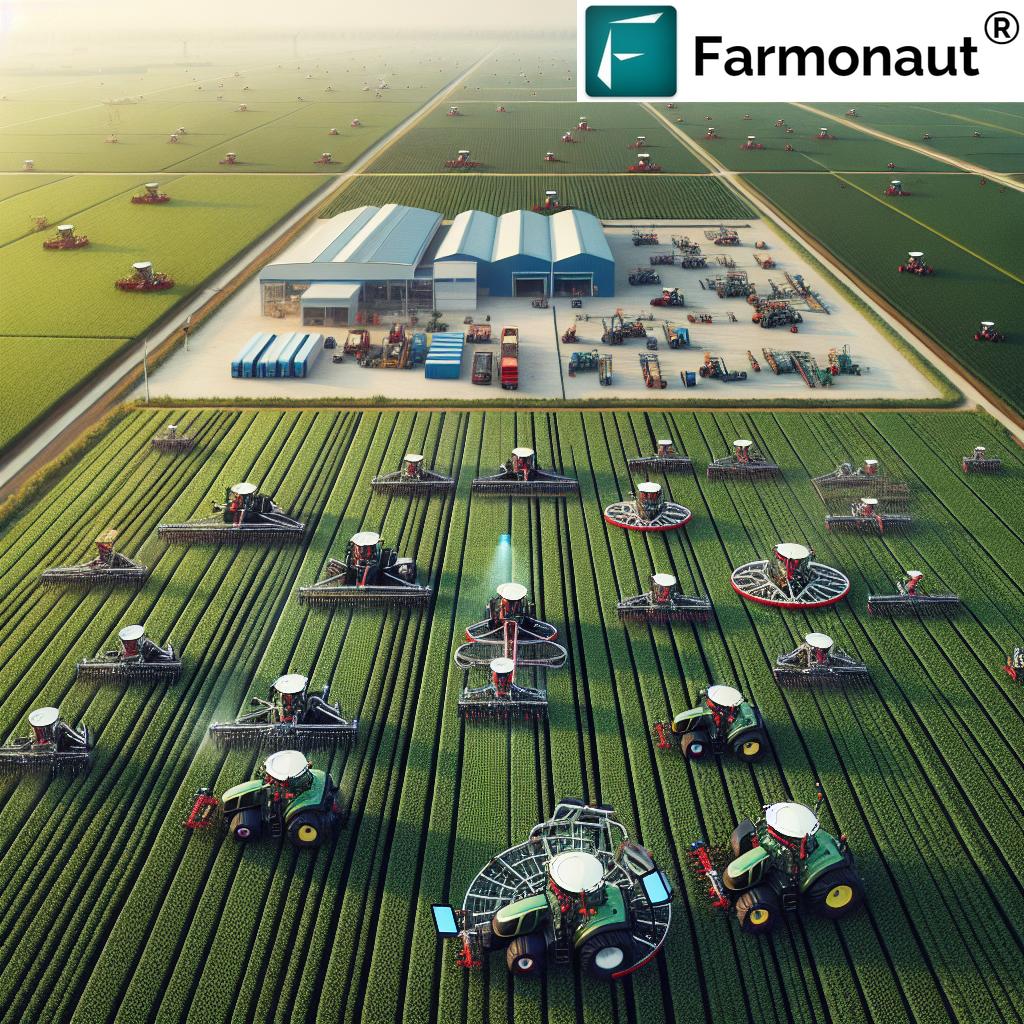Insect Farming & IoT Technology in India: 2025 Market
Table of Contents
- Introduction: Advancements in Farming Technology—India’s 2025 Agricultural Revolution
- What is Farming Technology? Redefining Indian Agriculture
- IoT Technology for Agriculture Market in 2025
- Insect Farming Technology Market: The Sustainable Protein of India’s Future
- Comparative Technology Adoption & Impact Table
- Old Farming Technology vs. Modern Techniques in India
- Technology in Farming in India: The Road Ahead to 2025 and Beyond
- Empowering Indian Farmers with Farmonaut’s Satellite Tech and AI Innovations
- FAQ: Insect Farming & IoT Technology in India
- Conclusion: Shaping Agriculture’s Future with Tech-Driven Sustainability
“By 2025, India’s insect farming market is projected to reach $100 million, driven by high-tech IoT solutions.”
Advancements in Farming Technology: Shaping the Future of Agriculture in India by 2025
As the global population continues to rise, the demand for food and sustainable agricultural practices becomes ever more urgent. In India, a nation where agriculture remains a critical sector supporting millions of livelihoods, the integration of modern farming technology is revolutionizing traditional agricultural methods. By 2025, the agriculture sector in India is poised to experience transformative changes led by advanced technologies, including IoT technology for agriculture, insect farming innovation, precision farming, and a synthesis of old wisdom with new advancements.
This comprehensive exploration will dive deep into how IoT and insect farming technology market trends are accelerating productivity and sustainability, why digital and mechanized tools outpace old farming technology, and how companies like Farmonaut are providing pivotal solutions for Indian farmers on the brink of a new agricultural era.
What is Farming Technology? Redefining Indian Agriculture
Farming technology encompasses tools, machinery, techniques, and innovations designed to improve efficiency, yield, and sustainability in agriculture. The range of technologies is extensive: from simple plows to sophisticated sensors, satellite-based monitoring, AI-driven analytics, and even blockchain for traceability. In essence, technology in farming in India is about solutions that:
- Optimize resource use (water, soil, fertilizers, labor)
- Reduce environmental impact
- Enhance crop yield and farm productivity
- Support sustainability and climate resilience
These innovations are driven by the urgency to meet the food demands of a growing population while minimizing waste, enhancing soil health, and integrating data-driven decision-making.
Key Concepts:
- Mechanized Equipment: Tractor plows, seed drills, combine harvesters, and custom irrigation systems reduce labor intensity and time.
- Fertilizers/Inputs: Chemical and organic fertilizers, improved hybrid seeds, and pesticides enhance crop health.
- Digital Technologies: Sensors for soil & weather, IoT-enabled drip irrigation, satellite and drone monitoring, AI-based crop advisory systems, and farm management platforms.
These advancements ensure enhanced productivity and sustainability in Indian fields, allowing smallholder and commercial farmers to make informed decisions with real-time data—a vital step as we approach 2025 and beyond.
For instant access to satellite-powered farm monitoring and AI-driven advice,
download the Farmonaut app:
IoT Technology for Agriculture Market in 2025: Transforming Smart Indian Farming
The IoT technology for agriculture market in India is expected to expand rapidly by 2025, with IoT (Internet of Things) standing as a genuine game-changer for Indian agriculture. IoT involves integrating sensors, GPS devices, and smart systems into farming operations, for real-time monitoring, analysis, and automation.
- Soil Moisture & Health Sensors: Monitor exact soil moisture, fertility, salinity, and temperature—a core aspect for precision agriculture.
- Weather Monitoring Stations: Enable tracking of weather patterns at the micro-level, helping farmers anticipate risks and schedule activities optimally.
- Crop Health & Pest Activity: Aided by satellite imagery (as provided through Farmonaut), farmers can proactively identify pest infestations and plant diseases early.
- Automated Drip Irrigation Systems: Deliver water precisely when and where it’s needed, conserving resources—critical in arid and water-stressed regions of India like Rajasthan and Maharashtra.
- Connected Drones & Automated Machinery: Streamline planting, fertilization, and harvesting, reducing manual labor dependency.
- AI & Data Analytics: Leverage satellite data, IoT devices and sensors for real-time insights, operational efficiency, and climate-smart practices.
Growth Projections:
- IoT agriculture market in India to reach multi-billion dollar valuations by 2025 (sources estimate over $4 billion by 2025), supported by government initiatives, decreasing sensor costs, and higher smartphone penetration among rural communities.
- IoT adoption will rise sharply from major agricultural states such as Punjab, Haryana, Karnataka, Maharashtra, Tamil Nadu, and Andhra Pradesh.
- Digital literacy campaigns and subsidies will further accelerate IoT device integration in Indian agriculture.
Farmonaut’s Jeevn AI Advisory System provides real-time, AI-derived satellite insights and custom recommendations for cropping cycles, water use, and climate threats. This helps farmers in various regions of India improve their productivity, reduce waste, and adapt to changing climate scenarios.
Insect Farming Technology Market: The Sustainable Protein of India’s Future
The insect farming technology market in India is emerging as a powerful weapon against food insecurity and waste management challenges. By 2025, the industry is expected to reach $100 million, with IoT-driven innovations at its core.
Insect farming refers to the cultivation of insects like black soldier flies, crickets, and silkworms for use in animal feed, organic fertilizer, and alternative protein for humans. In India, this is particularly revolutionary because:
- Minimal land and water use: Insects require just a fraction of resources compared to traditional livestock.
- Waste-to-wealth conversion: Insects convert agricultural by-products and food waste into high-value products.
- Lower greenhouse gas emissions: Insect farming emits far fewer GHGs than cattle or poultry farming.
- Fast and scalable protein production: Insect life cycles are short and create abundant protein, ideal for sustainable animal feed and potentially human food.
- IoT-based monitoring and automation: Ensures the right environmental conditions (temperature, humidity, feed levels)—ensuring greater yields, consistency, and monitoring of pest and disease outbreaks
These practices are part of a wider trend of India’s move towards sustainable agriculture and smart farming methods.
“IoT-powered insect farms in India are expected to increase production efficiency by up to 40% by 2025.”
IoT and digital tools are vital to scaling insect farming in India. Automated feeding, climate control, environmental monitoring, and pest detection using connected devices have the largest impact on ensuring high yields and product consistency—key to the sector’s exponential market growth.
Notably, emerging insect product companies in Indian cities like Bangalore, Chennai, and Hyderabad are using sensors to track insect growth, automating feeding times with programmable robotics, and connecting data to cloud-based platforms. This move is accelerated by the falling cost of sensors and the spread of IoT infrastructure into more rural communities.
Automated insect farming systems are already proving their value in areas such as:
- Rearing black soldier flies on agricultural waste to create protein-rich animal feed and organic fertilizers
- Boosting India’s silk industry with climate-adaptive, digitally managed silkworm rearing houses
- Developing sustainable, alternative protein solutions for India’s growing urban and rural population alike
Key drivers (government policies, subsidies, and a focus on rural tech innovation) are expected to push adoption even further by 2025.
Want to see how carbon footprint tracking and regenerative farming support sustainable insect protein production?
Explore the Farmonaut Carbon Footprinting solution here.
Comparative Technology Adoption & Impact Table for Insect Farming & IoT in India (2025 Projection)
As illustrated in this table, IoT adoption is concentrated around smart sensors, environmental monitoring, and feeding automation. Not only do these drive up productivity by up to 40%, but their sustainability impact (e.g., reduced waste, optimized energy use, traceability) is foundational for a modern, resilient agricultural market in India for 2025.
Farmonaut Blockchain Traceability enables food and insect product companies in India to ensure supply chain transparency for safer, trusted sourcing.
Old Farming Technology vs. Modern Techniques in India
Traditional agricultural methods and old farming technology, such as plowing with bullocks, relying solely on seasonal rainfall, and using manual pest control or folk knowledge, have sustained rural Indian communities for centuries. However, these archaic techniques are challenged by:
- Low productivity due to inefficient resource use
- Soil degradation from crop monoculture, over-tilling, and lack of precision practices
- Labor dependency—problematic with rural-urban migration
- Increasing vulnerability to climate variations and unpredictable weather patterns
In contrast, modern agricultural technology:
- Uses mechanized machinery and automated systems to reduce labor and boost consistency
- Employs sensors and IoT platforms for data-driven precision agriculture
- Supports sustainability through optimal use of water, soil health monitoring, and waste recycling (like insect-based organic fertilizer)
- Raises crop yields and enables climate-smart farming
- Integrates satellite, drone, and AI solutions for farm monitoring at scale
Yet, India’s future in agriculture doesn’t lie in discarding its indigenous wisdom. Rather, it’s about leveraging the best traditional practices—such as crop rotation, organic composting, and inter-cropping—and enhancing them with technology for adaptive, sustainable, and highly productive agriculture.
Interested in scaling your farm’s digital operations?
Try Farmonaut Large Scale Farm Management for seamless, high-efficiency monitoring and management.
Technology in Farming in India: The Road Ahead to 2025 and Beyond
By 2025, technology in farming in India will be defined by the smart blending of traditional heritage and digital innovation. Here’s what shapes the path forward:
- Government subsidies, education programs, and tech-focused development schemes fuel wider technology adoption in rural Indian communities.
- AI-driven crop advisory platforms and analytics (like Farmonaut’s Jeevn AI) help farmers make informed, real-time decisions about crop health, irrigation needs, pest & disease alerts, and marketplace pricing.
- Traceability and blockchain systems enable full transparency from field to fork—critical for food safety, reducing fraud, and building global market trust.
- Drones, connected machinery, and satellite data reduce operational costs and boost productivity on farms of all sizes.
- IoT-powered insect farming is also rapidly gaining traction for animal feed and protein, turning agricultural waste into resources and helping to solve India’s future food and circular economy challenges.
- Micro-climate and soil health monitoring supports selection of climate-resilient crop varieties and practices, enabling both big and small players to adapt to changing climate conditions.
Smarter, data-driven lending and insurance are unlocking new opportunities for India’s agricultural and insect farming markets. Farmonaut’s crop loan and insurance API solutions offer satellite-verified transparency for both banks and farms—reducing risks and simplifying access to finance.
Farmonaut Crop Loan and Insurance
Environmental regulations and carbon monitoring are rising in importance. Satellite-based environmental tracking, like Farmonaut’s, provides real-time carbon footprint, water usage, and emission data—precisely what progressive Indian farms and agri-businesses will need for future compliance and sustainability.
Explore Farmonaut Carbon Footprinting solution
Empowering Indian Farmers with Farmonaut’s Satellite Tech and AI Innovations
We, at Farmonaut, are dedicated to making satellite-driven insights, AI-powered advisory, and blockchain-enabled transparency affordable and accessible for Indian farmers, businesses, and government stakeholders. Our platform harnesses:
- Satellite-Based Monitoring: Real-time, multispectral data for crop health, soil conditions, and environmental impact
- Jeevn AI Advisory System: Provides actionable, automated insights for improving yields, resource use, and climate adaptation
- Blockchain Traceability: Ensures authentic, traceable agricultural and supply chain products
- Fleet & Resource Management: Maximizes vehicle, equipment, and workflow efficiency, reducing operational costs
- Environmental Monitoring: Delivers compliant carbon, water, and resource metrics for sustainability and reporting
Our services are available across Android, iOS, Web app, and API, including:
- Farmonaut Satellite Monitoring App
- Farmonaut API – Integrate our satellite, IoT, and AI data with your own agri-business systems
- Farmonaut API Developer Docs
Join us in building a resilient, sustainable, and data-driven future for Indian agriculture—empowering every facet, from smallholder farmers to the largest agri-enterprises and government agencies.
Farmonaut Fleet Management is your best bet for automating logistics and vehicle usage, especially on large insect or crop farms.
Farmonaut Subscription Plans
FAQ: Insect Farming & IoT Technology in India
Q1: What is the estimated value of the insect farming technology market in India by 2025?
The insect farming technology market in India is projected to reach approximately $100 million by 2025, driven substantially by the integration of IoT and automation solutions.
Q2: What are the most promising IoT innovations in Indian insect farming?
The top IoT technologies include smart sensors for climate parameters, automated feeding systems, environmental monitoring platforms, and blockchain-based traceability, each improving efficiency and sustainability.
Q3: How is technology in farming in India changing agricultural practices?
Modern technology—from satellite data and AI-driven platforms to IoT automation—is shifting agricultural practices towards greater precision, productivity, and sustainability. Old farming technology is now complemented by digital tools and new techniques.
Q4: How can insect farming contribute to sustainability?
Insect farming transforms agricultural waste into high-protein feed and organic fertilizer. It requires less land and water, emits fewer greenhouse gases, and is a pivotal part of India’s sustainable protein and waste management strategy.
Q5: What platforms offer real-time crop and insect farm monitoring in India?
Farmonaut provides satellite-based, AI-driven real-time crop and environmental monitoring for insect and traditional farms via Android, iOS, and web/browser apps and accessible API integration.
Q6: Where can developers find Farmonaut’s API information?
Developers can access our API developer documentation here.
Conclusion: Shaping India’s Agricultural Future with Tech-Driven Sustainability
The future of agriculture in India by 2025 stands at the intersection of innovation and heritage. The adoption of insect farming technology, combined with IoT-powered smart systems, advanced satellite analytics, and AI-driven farm management, is redefining this landscape.
As old farming technology gives way to a tech-enabled era filled with precision, transparency, and circularity, Indian farmers, agri-businesses, and communities gain unprecedented tools to meet rising food demands, improve livelihoods, and preserve environmental health amid ongoing climate change.
The insect farming technology market and the IoT technology for agriculture market in India are not just buzzwords—they represent an integrated approach to sustainable growth, greater productivity, and smart resource use in the world’s largest agricultural landscape.
We, at Farmonaut, are proud to provide the satellite, data, and digital infrastructure that enables this transformation, serving everyone from individual growers to government planners as India forges ahead into a sustainable, resilient agricultural future.













